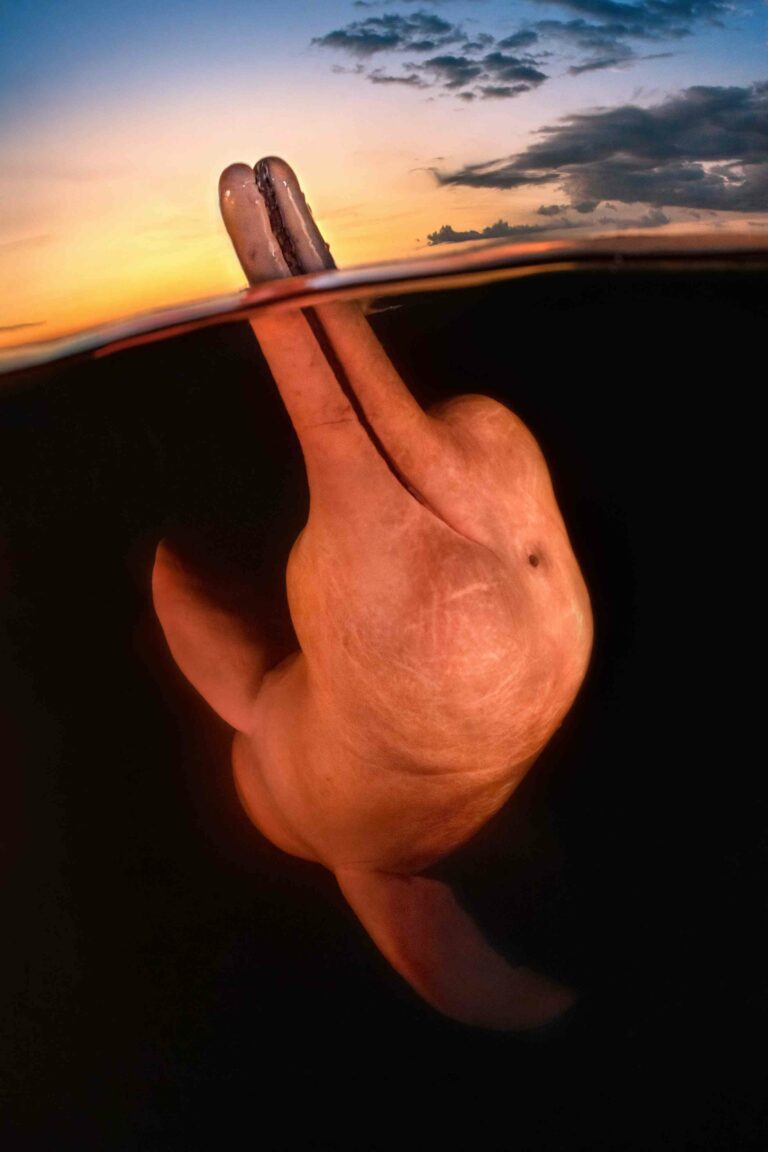A shot of a pink river dolphin breaching the Amazon’s surface was enough to see Kat Zhou from the USA named Underwater Photographer of the Year 2023. Her eye-catching photograph triumphed over some 6,000 other pictures, entered in 13 categories by underwater photographers from 72 countries.
“There’s a legend among locals that river dolphins, or botos, can transform into handsome men known as boto encantado to seduce women,” says Zhou, who gave that name to her photograph.
“Though I did not witness the transformation, I was enchanted by these beautiful mammals in a different way. After seeing how botos would sometimes bring their beaks above water, I wanted a split-shot at sunset. Though the water was so dark that I was shooting blind, this dolphin gave me a perfect pose and smile!”
As more people have settled the Amazon, river dolphins have been living closer to human populations, says Zhou. “Many have been killed for use as fish-bait, drowned in gill-nets or poisoned by mercury pollution from mining. I fear that one day botos will truly become no more than mythical creatures.”
The photo took first place in the Up & Coming category of the competition. “At first glance simple, then simply perfect,” was the assessment of the chair of the competition judges, Alex Mustard. “In dark, tannic waters, Kat has created a striking composition capturing this rarely photographed and endangered species in a precision composition.
“This is by far the best image we’ve ever seen of this species, whose numbers are declining at an alarming rate and whose IUCN’s Red List status was worryingly uprated to Endangered in 2019.
“It is appropriate that the Amazon, as the world’s mightiest river, has produced our overall winner. The Underwater Photographer of the Year [UPY] contest aims to celebrate underwater photography in all its diversity and we are delighted that this year’s awarded images come from the poles to the tropics, from all corners of the ocean, and from renowned freshwater bodies like the river Amazon and Lake Baikal. Being more than a nature contest, we even have winners taken in swimming pools.”
(The winning photo was taken with a Nikon D850, 8-15mm fisheye with Kenko 1.4x teleconverter, Nauticam NA D850 housing, two Inon Z330 strobes, f/13, 1/160th, ISO 400)
- 1) British Underwater Photographer of the Year winner: Ollie Clarke
- 2) Save Our Seas Foundation Marine Conservation Photographer of the Year: Alvaro Herrero (Spain)
- 3) Wide Angle Winner: J Gregory Sherman (USA)
- 4) Macro winner: Shane Gross (Canada)
- 5) Wrecks winner: Brett Eldridge (USA)
- 6) Behaviour winner: Yury Ivanov (Indonesia)
- 7) Portrait winner: Suliman Alatiqi (Kuwait)
- 8) Black & White winner: Don Silcock (Australia)
- 9) Compact winner: Enrico Somogyi (Germany)
- 10) British Waters Wide Angle winner & Most Promising British Underwater Photographer: Theo Vickers (UK)
- 11) British Waters Macro winner: Kirsty Andrews (UK)
- 12) British Waters Living Together winner: Dan Bolt (UK)
- 13) British Waters Compact winner: Tony Reed (UK)
British Underwater Photographer of the Year winner: Ollie Clarke
The annual UPY competition, which can trace its existence back to 1965, is based in the UK, and the judges of the 2023 event alongside Mustard were Peter Rowlands and Tobias Friedrich.
Ollie Clarke, an Englishman now living in Australia, was runner-up in the Up & Coming category won by Zhou, and won the title British Underwater Photographer of the Year 2023 for his image The Swarm.

“The whale sharks on the Ningaloo [Western Australia] are often accompanied by baitballs like this one, where the small fish use the shark as a floating shelter,” says Clarke. “However, this one was huge, much denser and with a lot more fish than usual, so I was really excited to photograph it.
“The shark almost looked as if it was getting fed up with the small fish and it was attempting to shake off the swarm. It would make steep dives and then ascend again right away thrashing its tail, but the fish would just swirl even more densely around the poor shark, who would have barely been able to see through the baitball!
“I was hoping to spend a bit of time photographing this shark, but after some ups and downs he disappeared into the depths of the Indian Ocean, an encounter I’ll never forget.”
“For me this is predator and the prey,” commented Alex Mustard. “Whale sharks are sometimes mis-labelled as plankton-feeders, but they are also active predators of schools of small fish. Ollie’s stunning image is perfectly timed as the shark pounces, switching from benign escort to hunter, mouth gulping down its prey.“
(Taken with a Sony A7Riii, 28-60, Nauticam WACP-1, Nauticam NA-A7Riii housing, f/8, 1/250th, ISO 400)
Other category winners are shown below, with the photographer’s own description and a judge’s comment:
Save Our Seas Foundation Marine Conservation Photographer of the Year: Alvaro Herrero (Spain)

“A humpback whale dies a slow, painful and agonising death [in Baja California, Mexico] after having its tail entangled in ropes and buoys, rendering its tail completely useless. A reflection of what not only our oceans are suffering, but also our planet, the product of man’s selfishness and lack of responsibility.
“Taking this photograph was, for me, the saddest moment I’ve experienced in the ocean. Especially because I have spent so much time with humpbacks under water, experiencing eye contact, interactions and seeing with my own eyes how they are sentient and intelligent beings.
“But I’m ‘happy’ at being able to capture that moment and show the world what is happening, what we are doing. I really hope this image make us aware, opens our eyes and drives us in to make real changes.”
Tobias Friedrich comments: “What a stunning image and what a message it delivers. I can’t imagine the sadness when this poor whale was discovered, but it was also a good decision to take a few images to get a message of awareness out to the public. For me it was clear from the beginning that this image was the winner of the category. Well done.”
(Taken with a Nikon D500, Sigma 10-20mm f4-5.6, Isotta D500 housing, f/6.3, 1/320th, ISO 200)
Wide Angle Winner: J Gregory Sherman (USA)
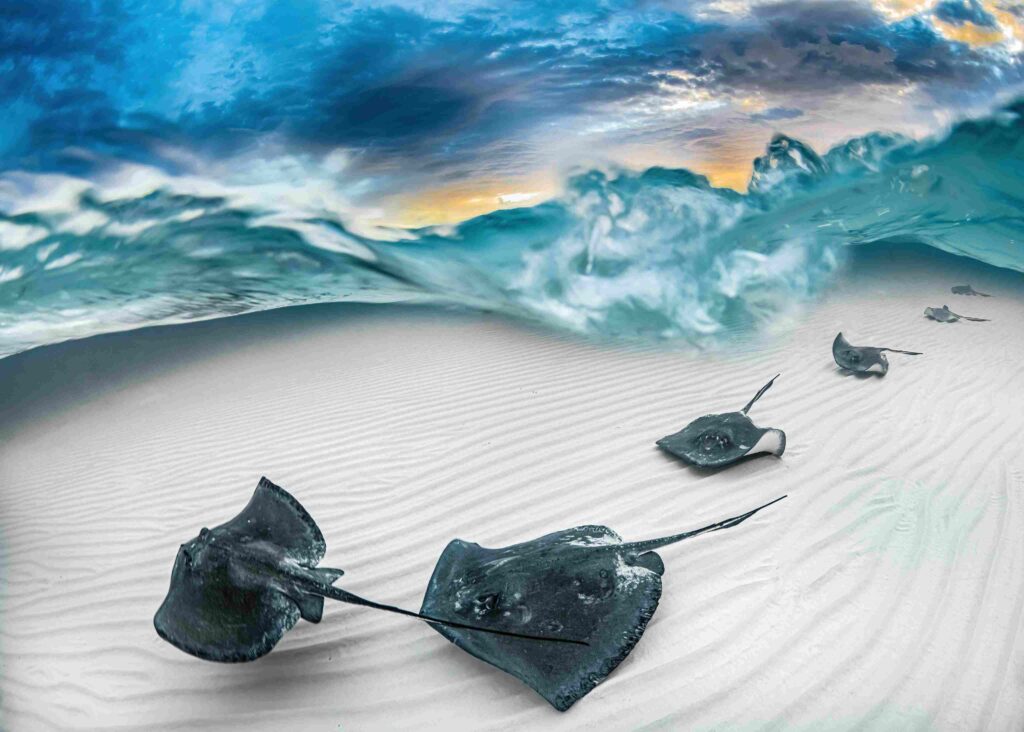
”My dive partner and I chartered a boat to arrive at Stingray City on Grand Cayman before dawn so as to capture the morning light and undisturbed sand ripples. Just as the sun broke the horizon, a line of southern sting rays headed straight for me and I captured this image as they glided across the sand.
“Using a large dome port allowed me to create a split image showing the intensely colourful dawn sky contrasted against the nearly monochromatic sting rays and sand beneath the surface chop.”
Peter Rowlands comments: ”The planning and the early start were rewarded by perfect sting ray behaviour topped with the dynamic split-shot of a dramatic sky. This image, quite rightly, went right to the wire as the possible overall winner. A week after the judging, I loved looking at this image again.”
(Taken with a Canon 5SR, 8-15mm, Subal housing, Sea & Sea YS-D2 strobes, f/5.6, 1/80th, ISO 1000)
Macro winner: Shane Gross (Canada)

”Walking along a rocky shoreline [on Vancouver Island] we would peer under rocks using a probe lens and my camera’s LCD screen to check for plainfin midshipman nests. Once found, I would lie on top of the barnacle-covered rocks, cutting my elbows, trying to compose images of fish most people have never heard of despite having one of the most interesting life-cycles of any animal.
“Plainfin midshipman are deepwater fish that travel to the intertidal zone to spawn. The males sing to attract females and she will lay as many eggs as his singing deserves before moving on to the next singer. Now the male has a chance to fertilise the eggs, but only if he is not beaten to the punch by a sneakier male who looks like a female. The singer male will then guard the nest, never knowing the kids may not be his. Drama!”
Alex Mustard comments: “A shoal of embryonic fish that are still attached both to the seabed and their egg-sacs – a secret image revealing another incredible insight into life in the sea. But the photo isn’t all about natural history, it is made by personality captured in the primary tiddler.”
(Taken with a Nikon Z6, Laowa Probe, no housing, Big Blue AL1200NP II torch, f/40, 1/200th, ISO 2000)
Wrecks winner: Brett Eldridge (USA)
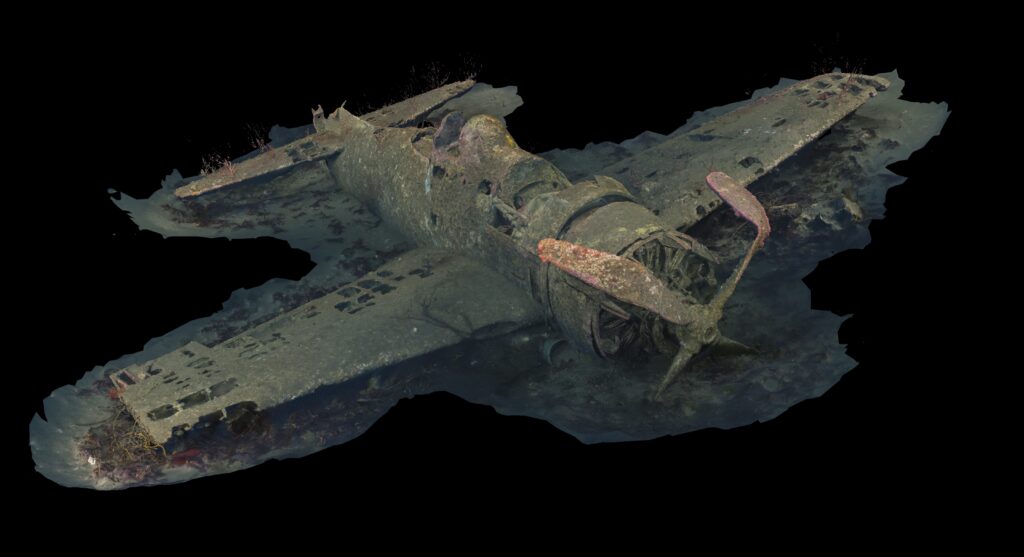
“We were out scanning targets in June [at Point Loma, California] when we saw a very small, but promising sonar blip 230ft deep. I geared up and jumped in hoping for something special. After some searching, my heart started racing when I first saw fish, then the propeller of an almost completely intact, single-engine WW2 airplane!
“It turned out to be a F8F-1 Bearcat, a rare aircraft that Neil Armstrong famously once said was his favourite and has been described as ‘an engine with a saddle’. Alone on the first dive with limited bottom time, I took enough photos to build a ‘draft’ model and identify the wreck.
“Needing a better photogrammetry model for the UPY contest and with deadlines quickly approaching, I booked 19 December and crossed my fingers. We fortunately had epic conditions and I got the photos I needed. It was my last dive of 2022.”
Alex Mustard comments: “Underwater photogrammetry that creates a 3D panorama of the subject is a recent technique in underwater photography that has proved incredibly useful for studying reefs and wrecks. It allows academics to study in detail, measure and visualise the underwater world without going down there.
“Yet Brett’s image also reveals how eye-catching these images can be, rewriting the rules of wreck photography under water and providing the world with its first view of this crashed WW2 fighter.”
(Taken with a Sonya 7rIV, 28-60 @ 28mm, Nauticam WWL1-B, Nauticam NA-A7RIV housing, two Keldan 8 x 18,000 lumen lights, f/8, 1/50th, ISO 1600)
Behaviour winner: Yury Ivanov (Indonesia)
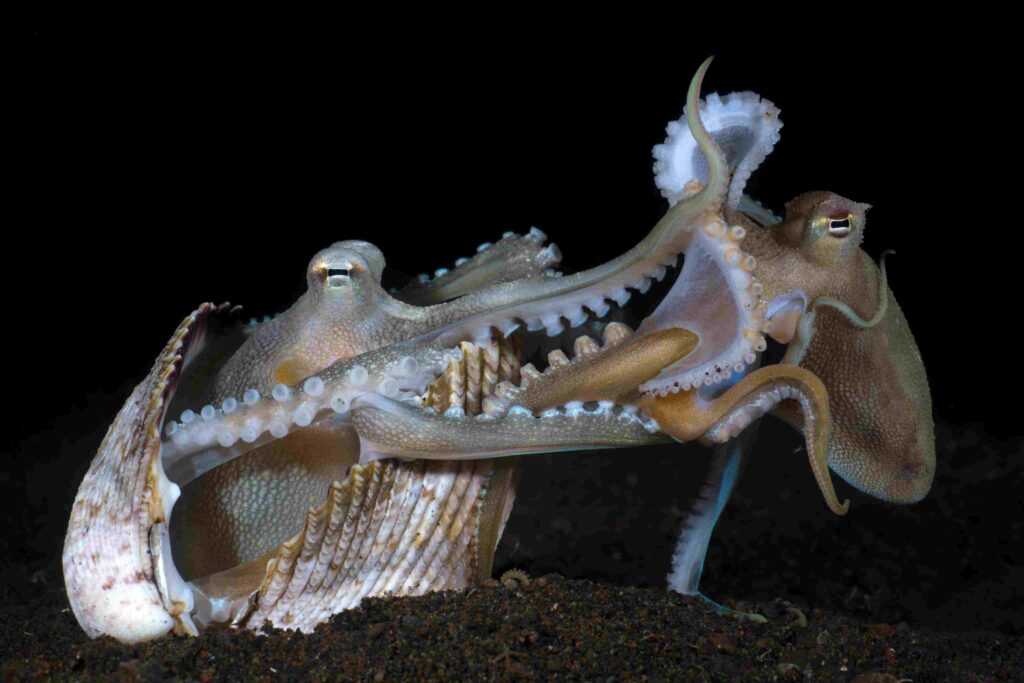
”A couple of coconut octopuses mating – I knew that I could find this species of octopus at one of the dive-sites near Tulamben village in Bali, and that they were active only at night-time in that place. I dived there only after 7pm, hoping to photograph something unique. I had done more than 30 night-dives at the site and finally got lucky. The photo shows the end of their love.”
Tobias Friedrich comments: “An absolute amazing moment, photographed perfectly. This image underlines that patience and knowledge of an animal will result in a winning shot. It was immediately clear to all judges that this image would go very far in the competition when we saw it the first time. Very well done and executed.“
(Taken with a Nikon D850, AF Micro-NIKKOR 60mm f/2.8D, Nauticam NA D850 housing, INON Z-330 Type 2 strobe, f/14, 1/250th, ISO 64)
Portrait winner: Suliman Alatiqi (Kuwait)
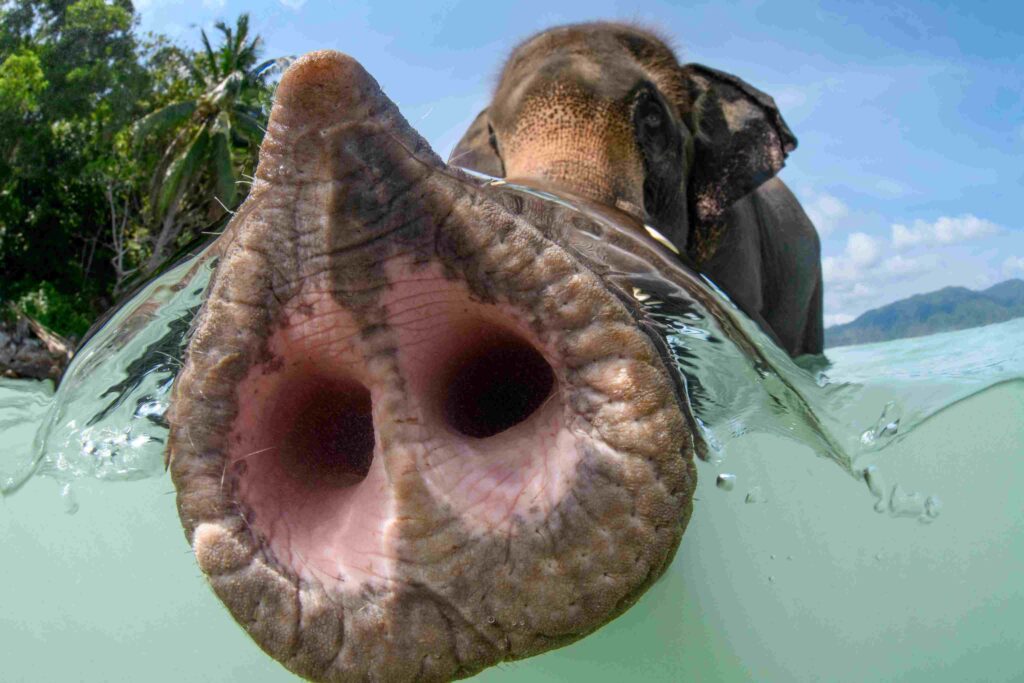
“The elephant’s trunk is one of the most distinctive anatomical features in the natural world and this photo [taken in Phuket, Thailand] aims to emphasise it. Luckily, he was curious about my camera and was happy to feel it out, which gave me the opportunity to capture this perspective, despite otherwise bad conditions for an over-under photo (choppy water and poor visibility).
“In my first attempts, the nostrils were not fully lit because of how close they were to the lens (which was necessary for the intended photographic effect). So I returned at a specific time-window when I thought the sun’s angle would be optimal and managed to fully light the nostrils. This added a lot more detail to the key part of the image, without which the photo would not be as effective.”
Alex Mustard comments: “There is irresistible charisma in this crowd-pleasing composition. In this joyous frame, a domesticated Indian elephant cools off in the sea, and curiously dips its trunk beneath the surface to investigate Suliman’s underwater camera.”
(Taken with a Nikon D850, AF-S Fisheye Nikkor 8-15mm f/3.5-4.5E ED, Nauticam NA D850 housing, f/20, 1/320th, ISO 1000)
Black & White winner: Don Silcock (Australia)
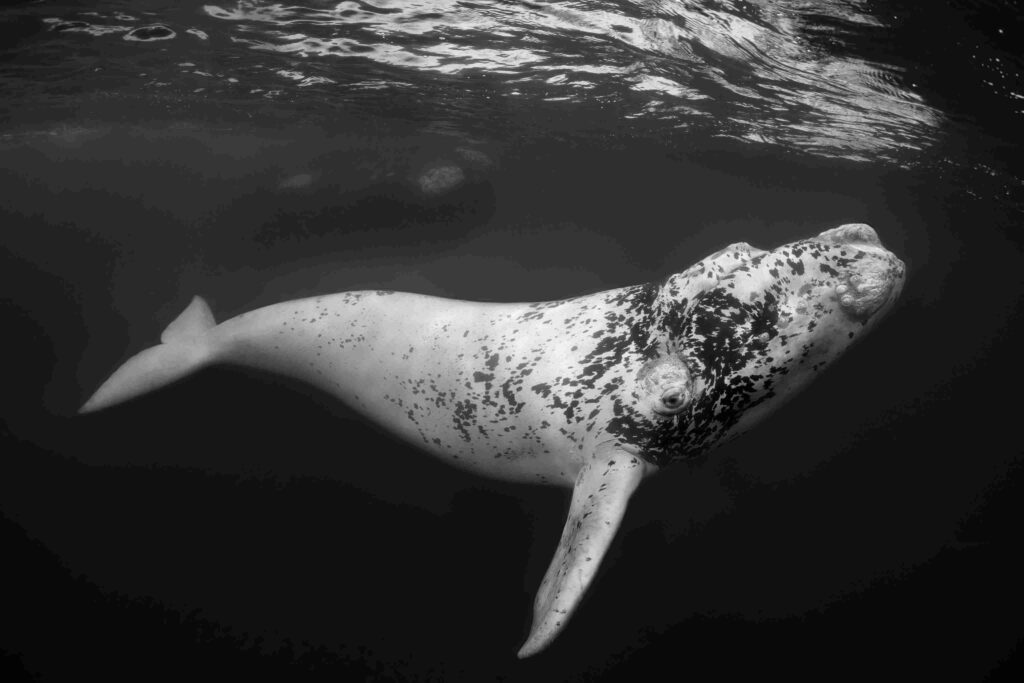
“The image was taken on the last morning of a five-day trip to Peninsula Valdés in Argentina, in August 2022, under a special permit to enter the water with the southern right whales that gather there between June and December each year.
“The mother, who can be seen in the background, accepted our presence and allowed the calf to interact with us. It was very playful but careful not to hit us with its tail and seemed to be really enjoying it all – almost as much as we were!
“White calves are very rare and referred to locally as El Blanco or the white one! Peninsula Valdés is an incredibly important safe haven and breeding ground for the southern right whales of the southern Atlantic, and Argentina has done an excellent job of managing it. It was, without doubt, my best-ever underwater experience!”
Tobias Friedrich comments: “This is an absolutely amazing example of how black and white images should be used. I can’t imagine it done much better actually – also, the encounter must have been truly stunning. Well-deserved winner of this category!”
(Taken with a Nikon D850, 28-70, Nauticam WACP-1, Nauticam NA D850 housing, f/10, 1/250th, ISO 320)
Compact winner: Enrico Somogyi (Germany)
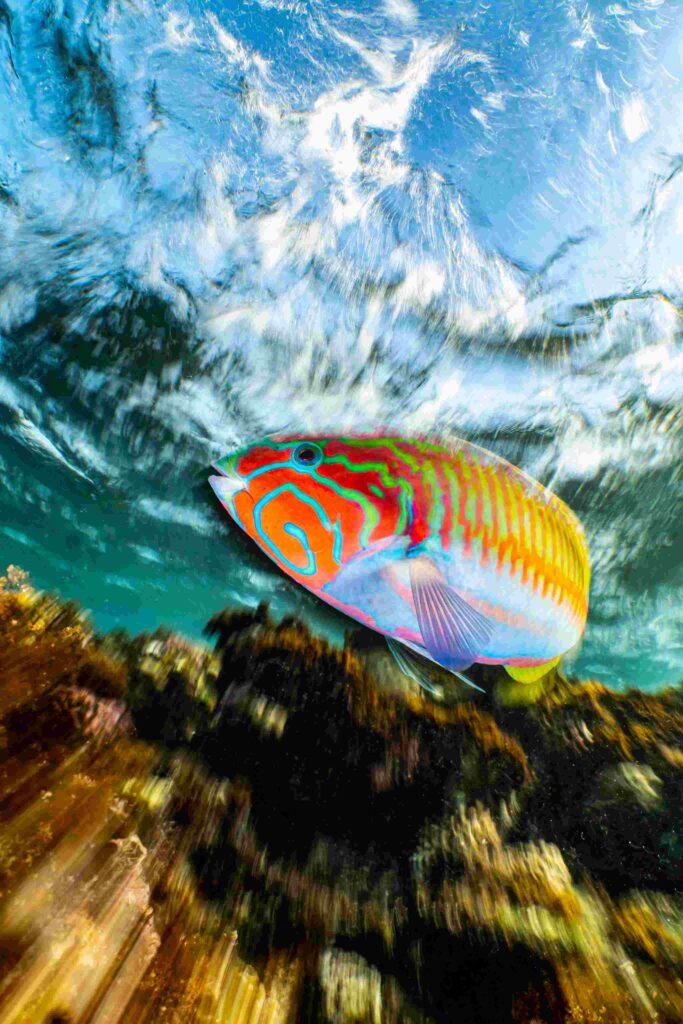
“When I was snorkelling in Marsa Alam [Egypt] I saw countless Klunzinger’s wrasses. One of them was particularly curious and very interested in my lens. I was able to take some good classic wide-angle pictures. After a while I figured it would be a good idea to try a long exposure, so I set my camera to the smallest aperture, f/11, the ISO value to 64 and the exposure time to 1/13th.
“For this picture, I moved the camera forward a bit while the shutter was released. This created the zoom effect in the lower part of the image. I was very happy with the result.”
Peter Rowlands comments: “An intelligent image playing to the camera’s strengths and producing an end-result that most bigger cameras would be proud of.”
(Taken with a Sony RX100VII, Nauticam EMWL 130, Fantasea FRX 100VII housing, two Retra Flash Pro strobes, f/11, 1/13th, ISO 64)
British Waters Wide Angle winner & Most Promising British Underwater Photographer: Theo Vickers (UK)
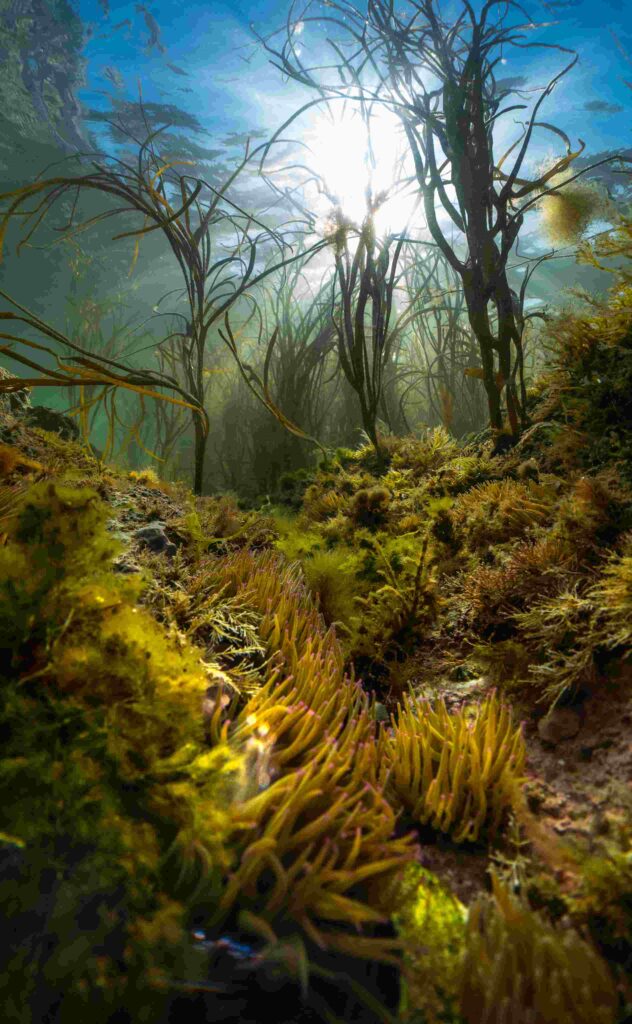
“Sunlight beats down through a marine jungle of Himanthalia algae on the chalk reefs of the Needles Marine Conservation Zone. The purple-tipped tentacles of snakelocks anemones (Anemonia viridis) rising up from the forest floor.
“Striking rock formations, the Needles on the Isle of Wight attracts close to 500,000 visitors annually. Yet, like many of Britain’s marine habitats, the beauty and biodiversity of the island’s chalk reefs that lie below, from nudibranchs and rays to cuttlefish and cuckoo wrasse, are largely unknown to most.
“Exploring the shallower reefs on a summer evening, my mission was to capture a wide-angle image that documented this stunning local habitat, combining both the towering forests above and the anemones that rule the chalk seabed below.
“After several unsatisfying attempts I stumbled upon this gully packed with snakelocks and, sinking into the forest beneath, found the composition I had been seeking.”
Tobias Friedrich comments: “What a stunning image! This magical and mystic atmosphere is just blasting. A very good example of what you can achieve even with a small camera and an artistic and good eye. The blurry foreground even gives you the impression that you are in a tiny world, looking up into the weed. Very well done! The only little, little downside is the sunburst, which is a bit too bright.“
(Taken with a Sony A6400, 16-50mm, Fantasea FA6400 housing, f/10, 1/160th, ISO 500)
British Waters Macro winner: Kirsty Andrews (UK)

“I have long admired others’ pictures of nudibranchs feeding on the egg-coils of other nudibranch species across the world. I’d also seen this nudibranch species, Favorinus branchialis, before, and I knew that it fed in this way, but had never seen it in action until recently.
“I was therefore thrilled to find three large specimens feeding on a big coil of eggs in Shetland, Scotland. The eggs were several inches across, in a wide spiral, so the challenge was to isolate an appealing composition of eggs and nudibranchs.”
Tobias Friedrich comments: “What a nice and clean composition of these nudibranchs. From the beginning this image caught my attention and I knew it was more than likely to win this category. It’s not only a macro shot but also a portrait and has additionally an element of behaviour. What more can you wish for? Very well done and congratulations!”
(Taken with a Nikon D500, 60mm, Nauticam NA D500 housing, two Retra Pro strobes, f/29, 1/250th, ISO 320)
British Waters Living Together winner: Dan Bolt (UK)
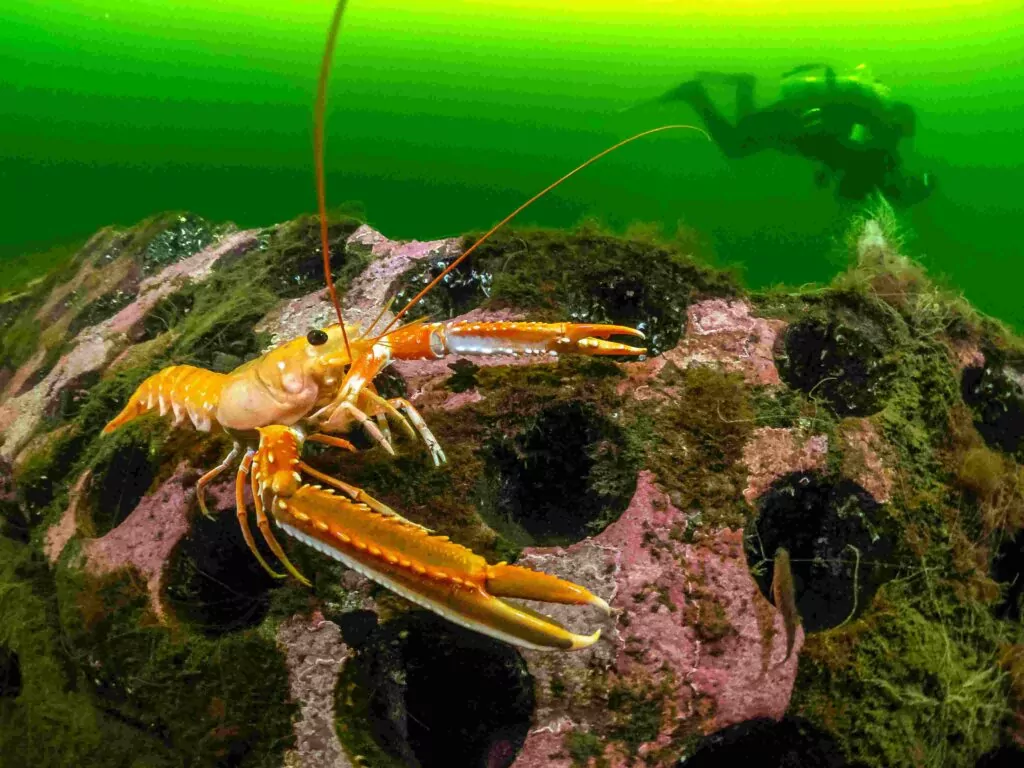
“We were initially interested in this site in Loch Fyne [western Scotland] for the fields of fireworks anemones, but of equal interest was an old pipe that had this patterned concrete protective covering along its length. This shallow artificial reef was home to many different species, including some large langoustines (Nephrops norvegicus) that were seemingly unperturbed by my presence.”
Alex Mustard comments: “A seabed structure provides the perfect habitat for marine life, and a great recreational dive-site for people. The composition balances perfectly the langoustine, as it scuttles across the intriguing structure, with the diver.”
(Taken with an Olympus OM-D E-M1, Panasonic 8mm fisheye, Aquatica A-EM1 housing, two Sea & Sea YD-D1 strobes, f/5.6, 1/30th, ISO 1250)
British Waters Compact winner: Tony Reed (UK)
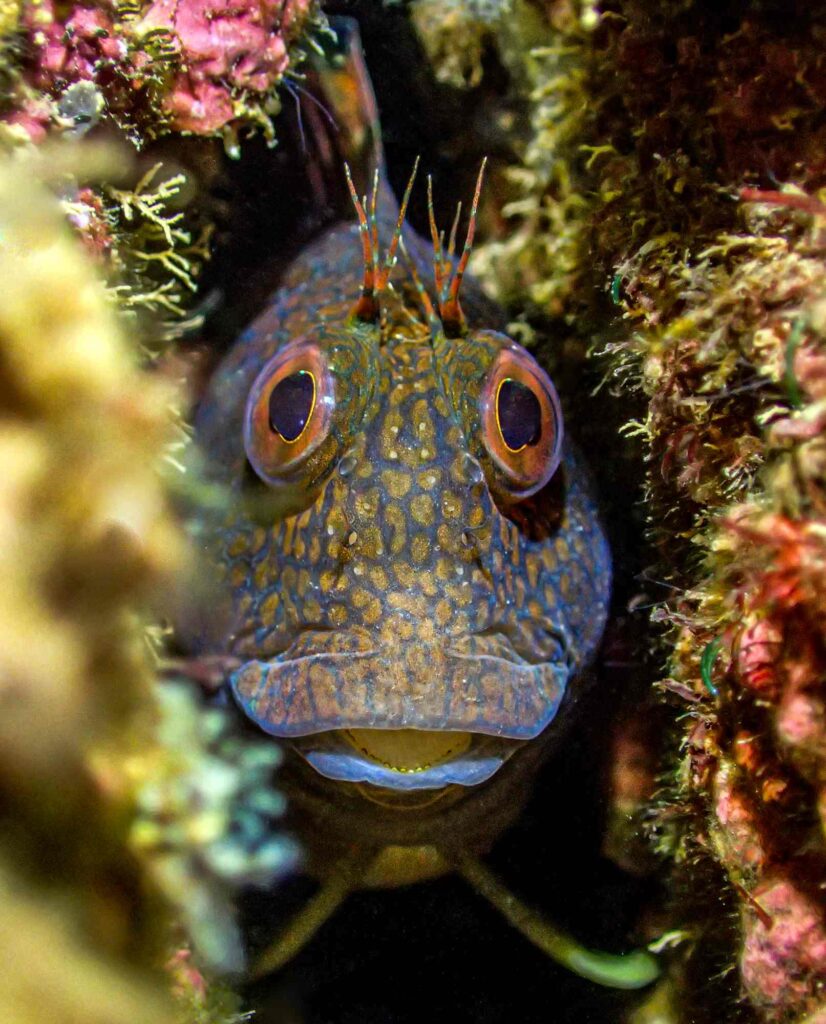
“I had been going back to this spot on Crack Rock [Babbacombe, Devon] to capture the variable blenny for several weeks. He was caring for his eggs inside the crevice so I was trying to capture the point when the eggs were hatching.
“Being such an inquisitive little chap he was always moving around, getting closer to the camera until he got to this point where I took a few shots. I didn’t stay too long as I didn’t want to have any negative or detrimental affects on the parenting behaviour. It has been great to see an increase in the variable blenny around Torbay over the past couple of years.”
Alex Mustard comments: “Variable blennies are relative newcomers to our shores and I cannot believe one has ever been captured as perfectly as this before. What a portrait!”
(Taken with an Olympus TG4, Olympus PT-056 housing, Light & Motion video light, f/4.9, 1/250th, ISO 200)
All the winning images can be seen in the Underwater Photographer of the Year’s Winner’s Gallery website and there is also a free downloadable eBook of winners. Yearbooks back to 2015 can also be downloaded at the site.
Also on Divernet: Underwater Photography Masterclass By Alex Mustard, Be The Champ! – Strobeless, Be The Champ! – Palau, Be The Champ! – Schools
